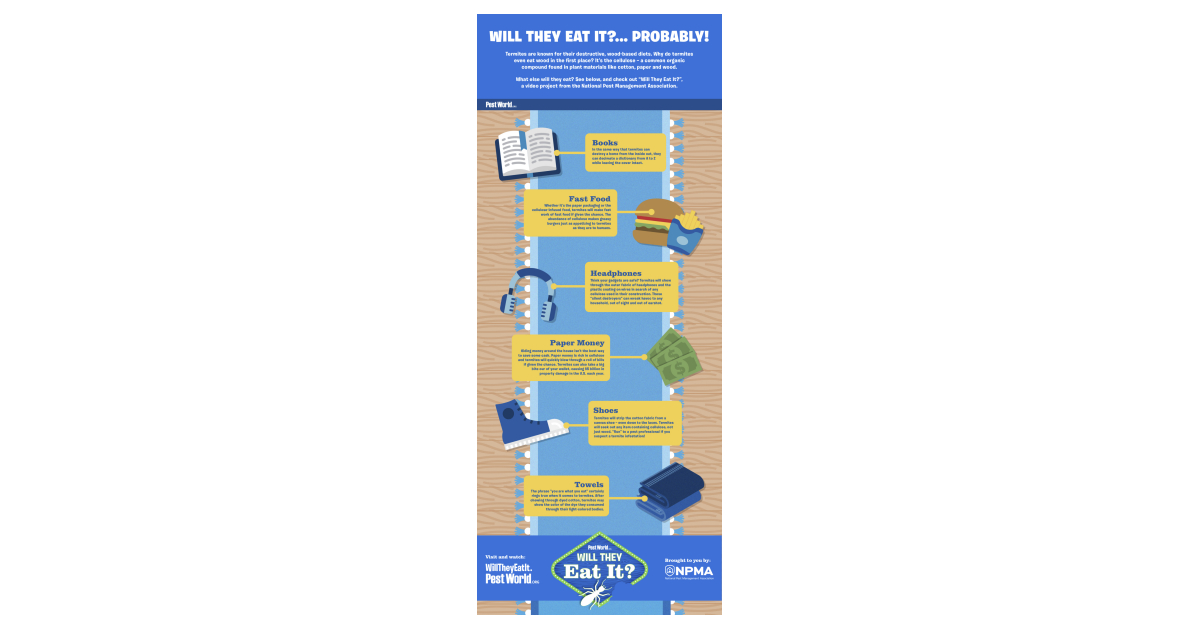100,000 Termites Ate WHAT?! - 5 minutes read
 100,000 Termites Ate WHAT?!
100,000 Termites Ate WHAT?!FAIRFAX, Va.--(BUSINESS WIRE)--It’s time for “Will They Eat It?” – an exciting new six-part video project brought to you by the National Pest Management Association (NPMA) that shows what really happens when everyday household objects are placed into a tank of 100,000 hungry termites to find out… “Will They Eat It?” While we all know that termites will sink their “teeth” into almost anything made of cellulose – a common organic compound found in plant materials like cotton, paper and wood – the “Will They Eat It?” video series unveils a number of surprising twists, shocking even NPMA’s own entomologist with which items the termites could not resist. As if eating Americans out of house and home to the tune of $5 billion a year in property damage wasn’t enough, these “silent destroyers” will also decimate other prized possessions, including some of your favorite dinner foods.
“While I’ve specialized in structural pests like termites for many years now, I couldn’t help but get excited when I saw the amount of damage they were able to inflict on each item in such a short period of time,” said Michael Bentley, Ph.D., entomologist for the National Pest Management Association and your host of “Will They Eat It?” “From making a bag of fast food literally disappear, to obliterating red and blue hand towels – and changing color themselves as a result – what better way to show just how fascinatingly voracious termites’ appetites really are than throwing everyday objects into a tank and watching them decimate it in no time at all!”
The drama will unfold with new episodes premiering every Thursday on WillTheyEatIt.pestworld.org as Dr. Bentley introduces items like a burger and fries, a dictionary, headphones, fake money, shoes and towels to these tiny terrors to find out “Will They Eat It?”
Drumroll (in case you can’t wait for the weekly reveal), our hungry termites couldn’t resist:
Burger & Fries: We all know how delicious fast food is, but for termites, the main course is the packaging. The termites devoured the paper bag and wax paper wrapping holding the food, as cellulose is a major compound in the makeup of paper. Perhaps most fascinating, however, is that the termites ate the entire burger but left the fries behind. Many fast food chains actually make their burgers with a filler known as powdered cellulose, infusing the compound into everything from buns to meats. This high abundance of cellulose makes greasy burgers just as appetizing to termites as they are to humans.
Dictionary: In the same way that termites can destroy a home from the inside out, they decimated the dictionary pages from A to Z but left the front cover intact. These results certainly echo the age-old advice not to judge a book by its cover.
Headphones: The termites ignored the noise and quickly got to work on the headphones, chewing through the outer fabric of the headband and ear cushions, as well as the foam cushions themselves. These “silent destroyers” can wreak havoc on any household, out of sight and out of earshot.
Fake Money: Termites can literally eat you out of house and home and can also take a big bite out of your wallet! Our termites ate through the currency layer by layer, feasting on the cellulose-rich paper bills. Termites can also burn through money by attacking wood structures, causing approximately $5 billion in U.S. property damage each year.
Shoes: Termites stripped the cotton fabric from a canvas shoe, illustrating just how quickly termites can chew through household items. Cellulose is the main structural component in plant materials including cotton textiles, which are typically found in many items throughout homes.
Towels: The phrase “you are what you eat” certainly rings true when it comes to termites. After chewing through dyed cotton wash cloths, the termites turned blue and red, absorbing the color of the dye they consumed.
If you suspect you have a termite problem, put down that burger and contact your local pest control professional immediately. For more information on termites, visit PestWorld.org. For updates on the “Will They Eat It?” project, visit WillTheyEatIt.PestWorld.org or follow social media channels.
The NPMA, a non-profit organization with more than 5,500 members, was established in 1933 to support the pest management industry's commitment to the protection of public health, food and property from the diseases and dangers of pests. For more information, visit PestWorld.org or follow on Facebook, Twitter, Pinterest and YouTube.
Source: Businesswire.com
Powered by NewsAPI.org
Keywords:
Termite • Fairfax, Virginia • Business Wire • National Pest Management Association • National Pest Management Association • Termite • Termite • Cellulose • Organic compound • Chemical substance • Cotton paper • Wood • National Pest Management Association • Entomology • Termite • Michael Bentley (historian) • Entomology • National Pest Management Association • Fast food • Headphones • Hamburger • French fries • Fast food • Main course • Packaging and labeling • Paper bag • Wax paper • Cellulose • Cosmetics • Termite • Hamburger • French fries • Fast food • Food drying • Cellulose • Meat • Cellulose • Termite • Termite • Headphones • Headphones • Textile • Headband • Ear • Foam • Big Bite • Currency • Cellulose • Paper • Banknote • Money • Wood • Shoe • Termite • Cotton • Textile • Canvas • Shoe • Termite • Cellulose • Cotton • You Are What You Eat • Cotton • Textile • Color • Dye • Termite • Pest control • Information • Social media • National Pest Management Association • Nonprofit organization • Social group • Pest (organism) • Industry • Organizational commitment • Protectionism • Public health • Disease • Risk • Information • Facebook • Twitter • Pinterest • YouTube •